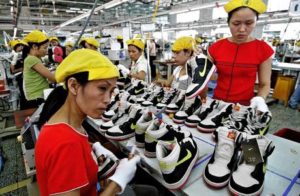Organise d by ECV International with the collaboration of LEFASO, the Vietnam Leather, Footwear, and Leather Goods Association, the 3rd edition of the Vietnam Footwear Summit was as important occasion for more than one hundred delegates coming from throughout all of Asia to interact with one another.
d by ECV International with the collaboration of LEFASO, the Vietnam Leather, Footwear, and Leather Goods Association, the 3rd edition of the Vietnam Footwear Summit was as important occasion for more than one hundred delegates coming from throughout all of Asia to interact with one another.
From the Summit, the increasingly important role of Vietnam on the global footwear manufacturing panorama clearly emerged: according to World Footwear Yearbook, in 2016 the state of Southeast Asia became the world’s third largest producer with a production of 1,185 million pairs, corresponding to a 5.2% share of global production, and the second exporter behind only China, with 1,021 million pairs exported, corresponding to a 7.4% share of global exports. The production is almost entirely on behalf of third parties and for private labels.
The main customers of the Vietnam footwear industry are the United States (33% of total exports), followed by China (7%), Germany (6%) and Japan. Nevertheless, the presence of Vietnamese footwear has by now become a global phenomenon playing an increasingly important role, as confirmed by Diep Thanh Khiet, LEFASO Vice President, during the summit: “I believe that the excellent performance of the Vietnamese footwear and leather goods industry will continue, and will even experience further growth in the years to come, driven by the signing of important trade agreements with leading markets like Japan, the Customs Union of Russia, Kazakhstan and Belarus, South Korea and ASEAN – the Association of Southeast Asian Nations, the TPP – Trans Pacific Partnership, and the agreement with the EU. Another key factor for its development is Vietnam’s demographic makeup, with 65% of the population now of working age, thus guaranteeing a more than abundant workforce. These two factors, together the focus on the production and export of high value products represent great opportunities for our industry “.
At the same time, next to the opportunities for growth, are a number of persisting problems that could slow down the process of growth for the leather and footwear industry in Vietnam: for example, not only are there the increasing costs of labour, but also competition from other manufacturing countries and protectionist threats.
Between 2010 and 2017, the cost of labour in Vietnam tripled, unlike the per capita income, which “only” doubled, threatening the possible outsourcing of production to destinations with lower labour costs like Cambodia, Myanmar, Bangladesh and Ethiopia. For now, such a move has been avoided thanks to the increased productivity of Vietnamese production plants: “The use of automation and Industry 4.0 technologies will help to further increase productivity – declared Diep Thanh Kiet – Low labour costs are not enough on their own to guarantee success, and companies must continue to encourage efficiency and make use of digital connectivity”.
The other serious threat is that of protectionist policies. In particular, there is the fear that the Trump administration will extend the measures it has taken against China to also include Vietnam. If this were to happen, it would be a problem. Nevertheless, Vietnam has signed other international trade agreements that seem to be much more solid: for example, the EVFTA-EU Vietnam Free Trade Agreement guarantees Vietnam simplified access to European technology and low entry costs into the vast EU market. There is then the creation of ASEAN, the Association of Southeast Asian Nations, which represents an opportunity for cooperation with other countries for the development of materials and new ways of sourcing. LEFASO representatives hope it will help reduce the costs of investments, while increasing productivity and contributing to maintaining market shares in the US, EU, and Japanese markets. As far as technology is concerned, Italy also plays an important role: in July 2017, in the district of Bihn Duong, the Italian-Vietnamese Footwear Manufacturing Technological Centre was inaugurated, thanks to the support of MISE and the ITA-ICE Agency, with Assomac – the National Association Manufacturers of Footwear, Leather Goods and Tannery Technologies playing the role of technological partner. An investment that reveals Italian expectations of further growth for the Vietnamese footwear manufacturing industry, with a subsequent increase in the number of business opportunities with local companies.
 Even as a market, Vietnam is rich in opportunity: according to the global consulting firm A.T. Kerney, the country has moved into sixth place in the Global Retail Development Index, growing by 7.7% in 2017. Currently extremely fragmented, the Vietnamese market counts 800 supermarkets, 150 malls, 9000 traditional points of sale and 2.2 million retailers: the presence of foreign retail is growing at an incredible rate and above all in the clothing-footwear segment, which last year registered the entry of international players like Zara, H&M and Uniqlo.
Even as a market, Vietnam is rich in opportunity: according to the global consulting firm A.T. Kerney, the country has moved into sixth place in the Global Retail Development Index, growing by 7.7% in 2017. Currently extremely fragmented, the Vietnamese market counts 800 supermarkets, 150 malls, 9000 traditional points of sale and 2.2 million retailers: the presence of foreign retail is growing at an incredible rate and above all in the clothing-footwear segment, which last year registered the entry of international players like Zara, H&M and Uniqlo.
As far as Italian businesses are concerned, its representation is good but for now limited to luxury brands, which are distributed only in the two main cities, where the most prestigious malls are located, like Trang Tien Plaza Center in Hanoi, the Vincom Center and the Runway luxury mall in Ho Chi Minh City.
Analysts expect that progress will continue to be made and that Vietnamese retail will rise in value to 179 billion dollars in 2020, with a 52% increase over the previous year. Accordingly, there is no lack of opportunity for those companies interested in penetrating this market. For now, Vietnamese buyers already came forward at Micam, the international fair of footwear in Milan, demonstrating a great interest in Made in Italy.



